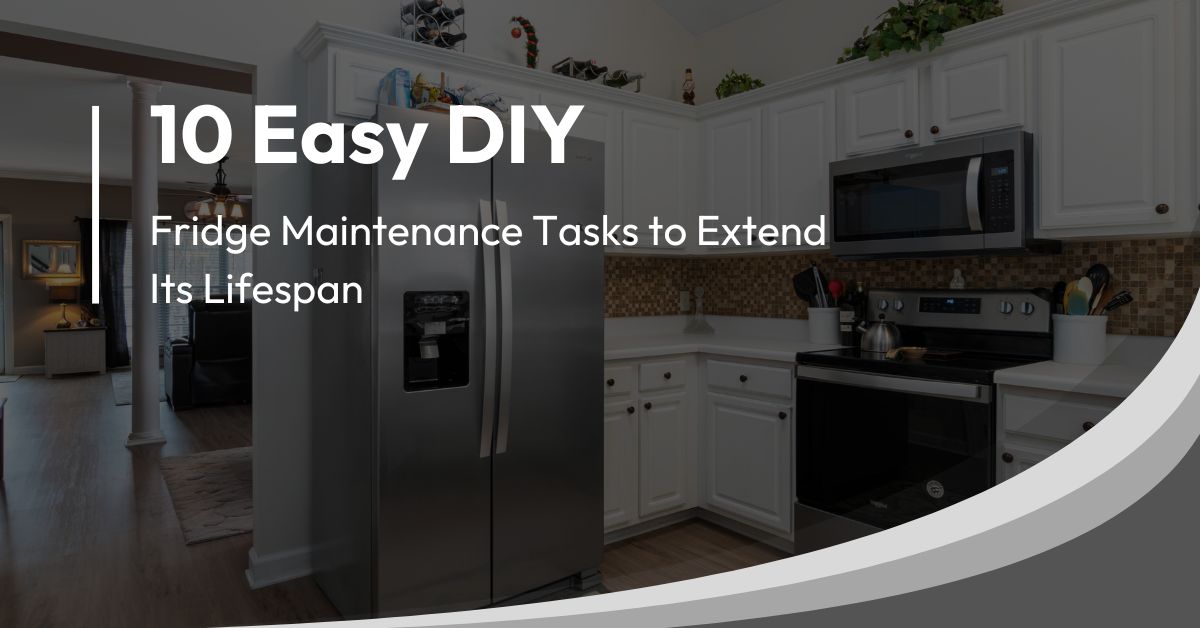Your refrigerator works hard 24/7 to keep your food fresh and safe. With a little TLC, you can help it run efficiently for years to come. Here are 10 simple DIY maintenance tasks that can extend your fridge’s lifespan and save you money on repairs and energy bills.
1. Clean the Condenser Coils
Frequency: Every 6 months
Why: Dirty coils make your fridge work harder, increasing energy consumption and wear.
How-to:
- Unplug the fridge or turn off the power.
- Locate the coils (usually at the back or underneath).
- Use a coil brush or vacuum with a brush attachment to remove dust and debris.
- Wipe down with a damp cloth if needed.
2. Check and Clean the Door Seals
Frequency: Monthly
Why: A tight seal keeps cold air in and warm air out, improving efficiency.
How-to:
- Inspect seals for cracks, tears, or food debris.
- Clean with warm, soapy water and a soft cloth.
- Dry thoroughly.
- If damaged, consider replacing the seal.
3. Calibrate the Temperature
Frequency: Quarterly
Why: Proper temperature ensures food safety and prevents unnecessary energy use.
How-to:
- Place a thermometer in a glass of water in the center of the fridge.
- Wait 24 hours.
- Temperature should be between 35°F and 38°F (1.7°C to 3.3°C).
- Adjust settings if needed and recheck after 24 hours.
4. Defrost the Freezer (Manual Defrost Models)
Frequency: When frost exceeds 1/4 inch
Why: Excessive frost reduces efficiency and storage space.
How-to:
- Remove all food and turn off the freezer.
- Place towels to catch water.
- Use a plastic scraper to remove frost (never use sharp objects).
- Wipe dry and turn the freezer back on.
5. Clean the Interior
Frequency: Monthly
Why: Prevents odors and bacterial growth.
How-to:
- Remove all food items.
- Take out removable parts like shelves and drawers.
- Wash with warm, soapy water.
- Wipe interior walls with a solution of baking soda and water.
- Dry thoroughly before replacing items.
6. Change the Water Filter
Frequency: Every 6 months or as recommended by manufacturer
Why: Ensures clean, fresh-tasting water and ice.
How-to:
- Locate the filter (usually inside the fridge or in the grille at the bottom).
- Follow manufacturer’s instructions for removal and replacement.
- Run several gallons of water through to clear the new filter.
7. Clean the Drip Pan
Frequency: Annually
Why: Prevents mold growth and unpleasant odors.
How-to:
- Locate the drip pan (usually underneath the fridge).
- Carefully pull it out.
- Wash with warm, soapy water.
- Rinse and dry thoroughly before replacing.
8. Vacuum the Compressor
Frequency: Annually
Why: Helps the compressor run efficiently.
How-to:
- Unplug the fridge.
- Locate the compressor (usually at the bottom back of the fridge).
- Use a vacuum with a brush attachment to remove dust and debris.
- Be gentle to avoid damaging any components.
9. Level the Fridge
Frequency: As needed or when moving the fridge
Why: Ensures proper door alignment and prevents excess wear on the motor.
How-to:
- Place a level on top of the fridge.
- Adjust the legs or rollers at the base of the fridge until it’s level.
- Ensure a slight tilt backwards for proper door closure.
10. Test the Door Alarm (If Applicable)
Frequency: Quarterly
Why: Ensures you’re alerted if the door is left open, preventing energy waste and food spoilage.
How-to:
- Open the fridge door and wait for the alarm to sound.
- If it doesn’t activate within the set time, consult your manual for troubleshooting or consider having it repaired.
Remember, always consult your refrigerator’s user manual before performing any maintenance tasks. If you’re unsure about any procedure, it’s best to consult a professional.
By incorporating these simple maintenance tasks into your routine, you can keep your fridge running efficiently for years to come. Not only will this save you money on energy bills and potential repairs, but it will also ensure your food stays fresher for longer.
Do you have any fridge maintenance tips to share? Let us know in the comments below!


Leave a Reply